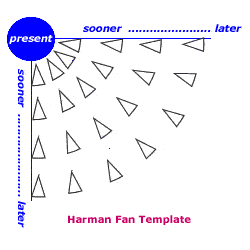|
|
SCENARIO BUILDING: The Harman Fan "maximizing development" approach summarized
from Willis Harman's An Incomplete Guide to the Future In An Incomplete Guide to the Future, Willis Harman discusses the necessity for thinking through the multiple causalities that produce an infinite array of alternative possible futures. He then describes how to mimic that pattern of development in scenario building. In its simplest form, this technique is based on group brainstorming, but could also be expanded to include phases of background research. Essentially, participants quickly brainstorm evocative titles for twenty-two "snapshots" of alternative futures: not fully described scenarios, just quick images of possibilities. This is best done using large (8X5) post-it notes and thick (readable at a distance) chisel-tip, watercolor magic markers (if you don't know why I specify watercolor, you've obviously never had a permanent marker bleed through paper onto the tablecloth beneath). As participants jot their ideas down, the post-it notes are arrayed on a wall or large whiteboard so that they are clearly visible to everyone. The group then discusses which of the "snapshots" seems closer to present conditions, and which seem to require longer-term, transformational changes. As the group discusses, the post-its are re-arranged to form rough groups of "near-future," "medium-term future," "long-term future," and "far future." Actual dates may be used, if the group desires and can agree on them. On a mural-sized sheet of paper, the facilitators have prepared a fan diagram in advance, like so:
Participants then discuss where in the chronology represented by the fan template different "snapshot" images of the future fall, and whether neighboring "snapshots" rely upon related trends and emerging issues of change. As the group discusses timelines and related lines of causality, the post-its are mapped onto the twenty-two different triangles on the fan. When the fan is complete, it may be used to tell different stories of how changes and innovations emerge, blend, and ricochet when intersecting: the different triangles are like stepping stones into the future, and different paths create scenarios that unfold in different patterns. For an example of the Harman Fan used to explore different possible futures unfolding for higher education and universities, view this powerpoint presentation, transcribed by Ruud van der Helm from an in-class exercise during the Futures Research Methods II graduate seminar of the Summer 2002 Residential Intensive Masters program in Studies of the Future at the University of Houston - Clear Lake. (All y'all ROCKED; special thanks to Ruud). NOTE: as the powerpoint example contains "active," clickable regions, it is best viewed in "slideshow" mode.
|
> Tools > Scenario Building > Schultz / Manoa | Schwartz / GBN | de Vries / Sociovision | Harman Fan
| 15
February 2003. Email
IF. Copyright © 2003, Wendy L. Schultz All rights reserved. |
people have explored our infinite futures. (in addition to the 17,500+ visitors from 10/1/2001-12/15/2002). |














